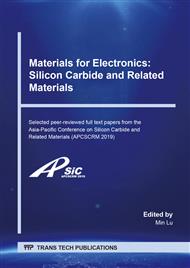[1]
H. von Wenckstern, Group-III Sesquioxides: Growth, Physical Properties and Devices, Adv Electron Mater, 3 (2017).
DOI: 10.1002/aelm.201600350
Google Scholar
[2]
O. Bierwagen, Indium oxide-a transparent, wide-band gap semiconductor for (opto)electronic applications, Semicond Sci Tech, 30 (2015).
DOI: 10.1088/0268-1242/30/2/024001
Google Scholar
[3]
J. Bai, M. Athanasiou, T. Wang, Influence of the ITO current spreading layer on efficiencies of InGaN-based solar cells, Sol Energ Mat Sol C, 145 (2016) 226-230.
DOI: 10.1016/j.solmat.2015.10.026
Google Scholar
[4]
Z. Chen, Y. Zhuo, W. Tu, X. Ma, Y. Pei, C. Wang, G. Wang, Highly ultraviolet transparent textured indium tin oxide thin films and the application in light emitting diodes, Appl Phys Lett, 110 (2017) 242101.
DOI: 10.1063/1.4986452
Google Scholar
[5]
W. Zheng, F. Huang, R. Zheng, H. Wu, Low-Dimensional Structure Vacuum-Ultraviolet-Sensitive (lambda < 200 nm) Photodetector with Fast-Response Speed Based on High-Quality AlN Micro/Nanowire, Adv Mater, 27 (2015) 3921-3927.
DOI: 10.1002/adma.201500268
Google Scholar
[6]
V.S. Vaishnav, S.G. Patel, J.N. Panchal, Development of ITO thin film sensor for detection of benzene, Sensor Actuat B-Chem, 206 (2015) 381-388.
DOI: 10.1016/j.snb.2014.07.037
Google Scholar
[7]
W. Zheng, R. Lin, Y. Zhu, Z. Zhang, X. Ji, F. Huang, Vacuum Ultraviolet Photodetection in Two-Dimensional Oxides, Acs Appl Mater Inter, (2018) 20696-20702.
DOI: 10.1021/acsami.8b04866
Google Scholar
[8]
T. Koida, M. Kondo, High electron mobility of indium oxide grown on yttria-stabilized zirconia, J Appl Phys, 99 (2006) 6.
DOI: 10.1063/1.2203722
Google Scholar
[9]
K.H.L. Zhang, D.J. Payne, R.G. Palgrave, V.K. Lazarov, W. Chen, A.T.S. Wee, C.F. McConville, P.D.C. King, T.D. Veal, G. Panaccione, P. Lacovig, R.G. Egdell, Surface Structure and Electronic Properties of In2O3(111) Single-Crystal Thin Films Grown on Y-Stabilized ZrO2(111), Chem Mater, 21 (2009) 4353-4355.
DOI: 10.1021/cm901127r
Google Scholar
[10]
Z. Chen, Y. Zhuo, R. Hu, W. Tu, Y. Pei, B. Fan, C. Wang, G. Wang, Control of morphology and orientation for textured nanocrystalline indium oxide thin film: A growth zone diagram, Mater Design, 131 (2017) 410-418.
DOI: 10.1016/j.matdes.2017.06.043
Google Scholar
[11]
P. Ágoston, K. Albe, Ab initio modeling of diffusion in indium oxide, Phys Rev B, 81 (2010) 195205.
DOI: 10.1103/physrevb.81.195205
Google Scholar
[12]
A. Regoutz, K.H.L. Zhang, R.G. Egdell, D. Wermeille, R.A. Cowley, A study of (111) oriented epitaxial thin films of In2O3 on cubic Y-doped ZrO2 by synchrotron-based x-ray diffraction, J Mater Res, 27 (2012) 2257-2264.
DOI: 10.1557/jmr.2012.162
Google Scholar
[13]
O. Bierwagen, M.E. White, M.Y. Tsai, J.S. Speck, Plasma-assisted molecular beam epitaxy of high quality In2O3(001) thin films on Y-stabilized ZrO2(001) using In as an auto surfactant, Appl Phys Lett, 95 (2009) 3.
DOI: 10.1063/1.3276910
Google Scholar
[14]
Z. Galazka, R. Uecker, K. Irmscher, D. Schulz, D. Klimm, M. Albrecht, M. Pietsch, S. Ganschow, A. Kwasniewski, R. Fornari, Melt growth, characterization and properties of bulk In2O3 single crystals, J Cryst Growth, 362 (2013) 349-352.
DOI: 10.1016/j.jcrysgro.2011.10.029
Google Scholar
[15]
C.V. Thompson, Structure evolution during processing of polycrystalline films, Annu. Rev. Mater. Sci., 30 (2000) 159-190.
DOI: 10.1146/annurev.matsci.30.1.159
Google Scholar
[16]
K.H.L. Zhang, A. Walsh, C.R.A. Catlow, V.K. Lazarov, R.G. Egdell, Surface Energies Control the Self-Organization of Oriented In2O3 Nanostructures on Cubic Zirconia, Nano Lett, 10 (2010) 3740-3746.
DOI: 10.1021/nl102403t
Google Scholar
[17]
H. Hayashi, T. Saitou, N. Maruyama, H. Inaba, K. Kawamura, M. Mori, Thermal expansion coefficient of yttria stabilized zirconia for various yttria contents, Solid State Ionics, 176 (2005) 613-619.
DOI: 10.1016/j.ssi.2004.08.021
Google Scholar
[18]
K.H.L. Zhang, V.K. Lazarov, T.D. Veal, F.E. Oropeza, C.F. McConville, R.G. Egdell, A. Walsh, Thickness dependence of the strain, band gap and transport properties of epitaxial In2O3 thin films grown on Y-stabilised ZrO2(111), J Phys-Condens Mat, 23 (2011).
DOI: 10.1088/0953-8984/23/33/334211
Google Scholar
[19]
C.S. Zhao, Z. Li, W. Mi, C.N. Luan, X.J. Feng, J. Ma, Structure and Optical Properties of Epitaxial Indium Oxide Films Deposited on Y-Stabilized ZrO2 (111) by MOCVD, J Electron Mater, 44 (2015) 2719-2724.
DOI: 10.1007/s11664-015-3755-z
Google Scholar
[20]
X.-Q. Shen, T. Takahashi, T. Ide, M. Shimizu, High-quality GaN film and AlGaN/GaN HEMT grown on 4-inch Si(110) substrates by MOCVD using an ultra-thin AlN/GaN superlattice interlayer, physica status solidi (b), 252 (2014).
DOI: 10.1002/pssb.201451478
Google Scholar


